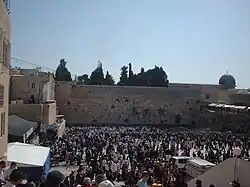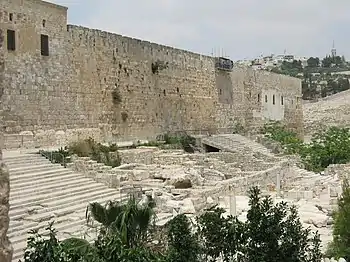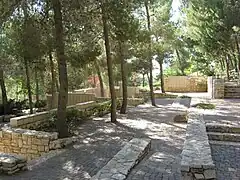The Judaism PortalJudaism (Hebrew: יַהֲדוּת, romanized: Yahăḏūṯ) is an Abrahamic monotheistic ethnic religion. It comprises the collective spiritual, cultural, and legal traditions of the Jewish people, having originated as an organized religion in the Middle East during the Bronze Age. Contemporary Judaism evolved from Yahwism, the cultic religious movement of ancient Israel and Judah, around the 6th/5th century BCE, and is thus considered to be one of the oldest monotheistic religions. Religious Jews regard Judaism as their means of observing the Mosaic covenant, which was established between God and the Israelites, their ancestors. Jewish religious doctrine encompasses a wide body of texts, practices, theological positions, and forms of organization. Among Judaism's core texts is the Torah, the first five books of the Tanakh, a collection of ancient Hebrew scriptures. The Tanakh, known in English as the Hebrew Bible, is also referred to as the "Old Testament" in Christianity. In addition to the original written scripture, the supplemental Oral Torah is represented by later texts, such as the Midrash and the Talmud. The Hebrew-language word torah can mean "teaching", "law", or "instruction", although "Torah" can also be used as a general term that refers to any Jewish text that expands or elaborates on the original Five Books of Moses. Representing the core of the Jewish spiritual and religious tradition, the Torah is a term and a set of teachings that are explicitly self-positioned as encompassing at least seventy, and potentially infinite, facets and interpretations. Judaism's texts, traditions, and values strongly influenced later Abrahamic religions, including Christianity and Islam. Hebraism, like Hellenism, played a seminal role in the formation of Western civilization through its impact as a core background element of Early Christianity. (Full article...) Selected Article A Kohen (plural: Kohanim) is a direct patrilineal descendant of Aaron, the brother of Moses. In the times of the Temple, Kohanim performed nearly all of the services there, where they were divided into twenty-four family groups, and led by the Kohen Gadol. They also recite the Priestly Blessing to the congregation in synagogues. Kohanim receive twenty-four gifts, only a few of which apply today. They are given precedence in many matters, including the reading of the Torah. Kohanim are also subject to a few prohibitions, including marrying a divorcee and entering a cemetery. (Read more...) Did You Know?Did you know...
Related Categories
Featured Articles
Related PortalsHistory Article The Acra was a fortified compound in Jerusalem of the 2nd century BCE. Built by Antiochus Epiphanes, ruler of the Seleucid Empire, following his sack of the city in 168 BCE, the fortress played a significant role in the events surrounding the Maccabean Revolt and the formation of the Hasmonean Kingdom. It was destroyed by Simon Maccabeus during this struggle. The exact location of the Acra, critical to understanding Hellenistic Jerusalem, remains a matter of ongoing discussion. Historians and archaeologists have proposed various sites around Jerusalem, relying mainly on conclusions drawn from literary evidence. This approach began to change in the light of excavations which commenced in the late 1960s. New discoveries have prompted reassessments of the ancient literary sources, Jerusalem's geography and previously discovered artifacts. Yoram Tsafrir has interpreted a masonry joint in the southeastern corner of the Temple Mount platform as a clue to the Acra's possible position. During Benjamin Mazar's 1968 and 1978 excavations adjacent to the south wall of the Mount, features were uncovered which may have been connected with the Acra, including barrack-like rooms and a huge cistern. (Read more...) Picture of the WeekIn the News
Featured Quote
WikiProjects
Things You Can Do
Weekly Torah PortionTopicsAssociated WikimediaThe following Wikimedia Foundation sister projects provide more on this subject:
Discover Wikipedia using portals
| |||||||||||||||



